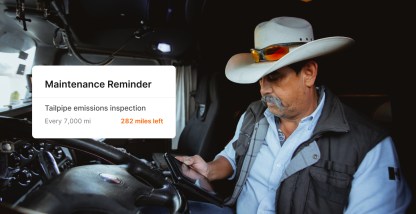- The FMCSA provides guidelines that cover the non-business use of a commercial vehicle, including to and from the driver’s home terminal and residence, restaurants, and hotels during rest periods when dispatched, or finding safe resting locations after running out of hours during loading or unloading.
- The FMCSA updated personal conveyance guidelines in June 2018.
- ELDs are required to allow carriers to enable personal conveyance and yard moves.
Personal conveyance with a trailer or with cargo but for non-business use is an important topic for those in the trucking industry. On Dec. 19, 2017, the Federal Motor Carrier Safety Administration (FMCSA) issued a proposal that aimed to slightly modify the existing guidelines for drivers who use their trucks for personal use. It included driving to and from the driver’s home terminal and residence, restaurants, and hotels during rest periods when dispatched or finding safe resting locations after running out of hours during loading or unloading, all while off-duty.
The term personal conveyance is also known as the movement of a commercial motor vehicle (CMV) for non-business use while off the clock. In light of the ELD mandate, drivers have some questions regarding how to properly document these hours.
The guidelines are primarily related to hours-of-service regulations and not strictly the ELD mandate. However, questions concerning commercial trucks being used for personal use became that much more pressing once the ELD mandate went into effect on Dec. 18, 2017. Properly documenting time spent traveling back and forth from pickups and deliveries were addressed, and under the new guidance, drivers can commute home from their work reporting location.
The regulatory guidance published in June of 2018 by the FMCSA loosened many of the personal conveyance requirements on CMVs. This change allowed truck drivers to use their vehicles for personal purposes if they were carrying work or load-related materials if the equipment was, at that particular time, not in use for commercial gain.
The FMCSA posted a notice in the Federal Register about the proposed changes and sought comments from stakeholders for the following 30 days.
Regulatory guidance changes concerning personal conveyance
The newest guidelines went into effect Dec. 19, 2017, and they are as follows:
The Federal Motor Carrier Safety Regulations (FMCSRs) require drivers to document their hours of service (HOS) on records of duty status (RODS), identifying one of four duty status options:
- on-duty not driving,
- driving,
- sleeper berth, and
- off-duty
This policy aligns with electronic logging devices, which are to be set to personal conveyance mode so that the device’s location function changes as it tracks the vehicle with a lower level of precision (approximately a 10-mile radius) via GPS (instead of the one-mile radius required for on-duty recording).
The FMCSA has confirmed this on its site’s FAQ page:
“When the personal conveyance status is selected (as allowed and configured by the motor carrier), the CMV’s location is recorded with a lower level of precision (i.e., an approximate 10-mile radius).”
The rule further states that a truck driver operating a commercial motor vehicle under one of the special driving categories:
“(i) Must select on the ELD the applicable special driving category before the start of the status and deselect when the indicated status ends, and
(ii) When prompted by the ELD, annotate the driver’s ELD record describing the driver’s activity.”
The FMCSA, in the end, did not expect drivers of tractor-trailer combination vehicles to drop their trailers before using their trucks for personal purposes. Their focus pivoted from whether a truck was loaded at all to the circumstantial motivations while driving, and the continued focus on driving safely.
FMCSA regulations explained
According to the FMCSA’s notice on the changes, the guidance permitted drivers to use their truck when off-duty for “time spent traveling from a driver’s en route lodging” (e.g., a motel or truck stop), “to restaurants and entertainment facilities and back to the lodging.”
A few of the other permitted circumstances for personal conveyance are:
- Commuting between the driver’s terminal and his or her residence, between trailer-drop lots and the driver’s residence, and between work sites and his or her residence. In these scenarios, the commuting distance combined with the release from work and start to work times must allow the driver enough time to obtain the required restorative rest as to ensure the driver is not fatigued.
- Time spent traveling to a nearby, reasonable, safe location to obtain required rest after loading or unloading. The time driving under personal conveyance must allow the driver adequate time to obtain the required rest in accordance with minimum off-duty periods under 49 CFR 395.3(a)(1) (property-carrying vehicles) or 395.5(a) (passenger-carrying vehicles) before returning to on-duty driving, and the resting location must be the first such location reasonably available.
- Moving a CMV at the request of a safety official during the driver’s off-duty time
- Time spent traveling in a motorcoach without passengers to en route lodging (such as motel or truck stop), or to restaurants and entertainment facilities and back to the lodging. In this scenario, the driver of the motorcoach can claim personal conveyance provided the driver is off-duty. Other off-duty drivers may be on board the vehicle, and are not considered passengers.
- Time spent transporting personal property while off-duty.
- Authorized use of a CMV to travel home after working at an offsite location.
The FMCSA emphasized that personal conveyance under the revised guidance does not cover “movement of a (truck) to enhance operational readiness,” such as moving closer to a pickup location or drop-off point.
These are also prohibited from personal conveyance with a trailer:
- Driving bobtail or with an empty trailer to a location to pick up another load.
- Driving an unloaded truck to a designated parking area after being unloaded.
- Repositioning a CMV or trailer in the direction of the motor carrier.
- The movement of a CMV in order to enhance the operational readiness of a motor carrier. For example, bypassing available resting locations in order to get closer to the next loading or unloading point or other scheduled motor carrier destination.
- After delivering a towed unit, and the towing unit no longer meets the definition of a CMV, the driver returns to the point of origin under the direction of the motor carrier to pick up another towed unit.
- Time spent transporting a CMV to a facility to have vehicle maintenance performed.
The FMCSA sought feedback from industry stakeholders to learn about other circumstances and scenarios in which personal conveyance would be appropriate.
Because personal conveyance is considered off-duty time, it will not have any effect on drivers’ HOS. However, it is important to note that the provision in CFR § 392.3 of the FMCSRs, a prohibition on the operation of a commercial motor vehicle while ill or fatigued, continues to apply.
Thankfully, there are technical advancements out today that can make meeting these regulations a much simpler task.
Gain a deeper understanding of the FMCSA personal conveyance rules.
Technology supports personal conveyance with a trailer
Today’s fleet management solution can help drivers and fleets stay on the right side of personal conveyance regulations.
Advancements in asset tracking can help verify records of duty status (RODs) in the event there are discrepancies or when contesting violations. Since the regulation states that time spent transporting a CMV to have maintenance performed does not qualify as a personal conveyance circumstance, staying abreast of vehicle diagnostics can be key to operational efficiency.
Revisions to industry standards, like the ones made to personal conveyance, aim to result in safer roads for all. Through informed cooperation with the FMCSA regulations and the right tools, safe driving can hopefully become the everyday expectation.







